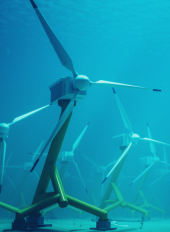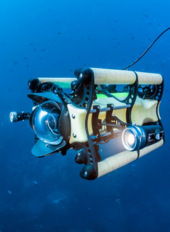-
View Profile
Co-Founder – Director
The Rise of Subsea Robotics and its Impact on the Industry
Offshore Geosciences
Co-Founder – Director
Subsea robotics are rapidly transforming the offshore wind, oil & gas, and renewable energy industries.
This article delves into how these technologies are rising to meet industry challenges, the substantial benefits they bring, emerging trends shaping the field, and the key challenges facing the subsea robotics sector.
Subsea services have become indispensable in the offshore wind, oil & gas, and renewable energy sectors. These industries rely on underwater operations for tasks such as installation, inspection, maintenance, and decommissioning.
The harsh and often hazardous underwater environment necessitates the use of advanced technologies to ensure efficiency and safety.
Subsea robotics, with their ability to perform complex tasks remotely, have emerged as a game-changer for the below core industry challenges:
The underwater environment is inherently hazardous. High-pressure conditions, strong currents, and low visibility pose significant risks to human divers. The industry has long sought ways to minimise these dangers, and subsea robotics provide an ideal solution.
Remotely operated vehicles (ROVs) and autonomous underwater vehicles (AUVs) can perform complex tasks without human presence, significantly reducing the risk of accidents.
The cost of offshore operations has been escalating due to deeper water exploration, more complex installations, and stricter regulatory requirements. Subsea robotics can help mitigate these costs by enhancing operational efficiency and reducing downtime.
Their precision and ability to work continuously without breaks contribute to lower overall project costs.
Stricter environmental regulations require the industry to minimise its impact on marine ecosystems. Subsea robots, with their precise and targeted operations, can help comply with these regulations.
They can conduct detailed environmental assessments and monitoring, ensuring that offshore activities are environmentally sustainable.
Accurate data is crucial for decision-making in the offshore industries. Traditional methods of data collection are often slow and prone to errors.
Subsea robotics equipped with advanced sensors can gather high-quality data more efficiently, providing real-time insights that are critical for effective decision-making.
Subsea services have become indispensable in the offshore wind, oil & gas, and renewable energy sectors. These industries rely on underwater operations for tasks such as installation, inspection, maintenance, and decommissioning.
The harsh and often hazardous underwater environment necessitates the use of advanced technologies to ensure efficiency and safety.
Subsea robotics, with their ability to perform complex tasks remotely, have emerged as a game-changer for the below core industry challenges:

AUVs are at the forefront of subsea robotics innovation. Advances in battery technology, navigation systems, and AI have significantly enhanced the capabilities of AUVs, making them more reliable and efficient. AUVs can perform tasks such as pipeline inspection, seabed mapping, and environmental monitoring autonomously, reducing the need for human intervention.

AI and machine learning are transforming subsea robotics by improving data processing and decision-making. These technologies enable robots to analyse vast amounts of data collected underwater and make real-time adjustments to their operations. For example, AI algorithms can help identify patterns in inspection data that indicate potential issues, allowing for proactive maintenance.

There is a growing trend towards using renewable energy sources to power subsea robots. This not only reduces the environmental impact of these operations but also enhances the sustainability of offshore projects. For instance, wave and tidal energy can be harnessed to power underwater sensors and robotic systems, creating a more eco-friendly approach to subsea operations.

Advancements in underwater communication technology are improving the control and data transmission capabilities of subsea robots. High-speed, high-bandwidth communication systems allow for better coordination between surface operators and underwater vehicles, leading to more efficient and effective operations. Innovations in acoustic communication are particularly promising, providing more reliable and faster data exchange.

Robotics-as-a-Service (RaaS) is emerging as a new business model in the subsea sector. This model allows companies to access the latest robotic technologies without the need for significant upfront investment. Service providers offer robotics solutions on a subscription basis, covering maintenance, upgrades, and operational support. This model is particularly attractive for smaller companies and startups looking to leverage advanced robotics without incurring high costs.
Subsea robotics are used for a variety of tasks in underwater environments, including inspection, maintenance, data collection, and repair operations in the offshore wind, oil & gas, and renewable energy industries.
Subsea robotics offer several benefits, including enhanced operational efficiency, improved safety by reducing the need for human divers in hazardous environments, and cost savings through reduced downtime and maintenance costs.
Emerging trends in subsea robotics include the development of autonomous underwater vehicles (AUVs), advancements in artificial intelligence and machine learning, integration of renewable energy sources, and enhanced underwater communication systems.
The subsea robotics industry faces challenges such as technical complexity, high development and deployment costs, and navigating regulatory environments to ensure safety and environmental compliance.
Subsea robotics are revolutionising offshore operations by providing solutions for inspection, data collection, and maintenance, operating in extreme conditions and enabling precise and efficient execution of tasks.
AI improves subsea robotics by enhancing data processing and decision-making capabilities, enabling robots to analyse data in real-time, identify patterns, and make adjustments to their operations for increased efficiency and effectiveness.
The rise of subsea robotics is not just a technological advancement but a strategic response to critical industry challenges.
By addressing safety concerns, operational costs, regulatory compliance, and the need for high-quality data, subsea robotics are transforming how offshore operations are conducted. The integration of AI, renewable energy, and enhanced communication systems marks a significant evolution in the field, pushing the boundaries of what is possible underwater.
However, the industry must continue to navigate technical complexities, financial barriers, and regulatory landscapes to fully capitalise on these innovations. By investing in advanced engineering, fostering financial support, and developing robust data management systems, the subsea robotics sector can achieve sustainable growth and drive significant advancements in offshore wind, oil & gas, and renewable energy industries.
As these technologies continue to evolve, staying at the forefront of innovation will be crucial for maintaining competitive advantage and operational excellence in this dynamic and rapidly changing field.